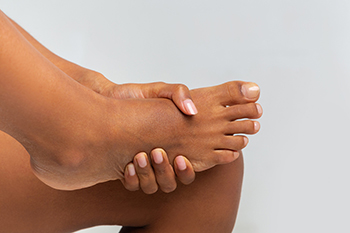Items filtered by date: November 2024
Are You Suffering From Ingrown Toenails?
Podiatrists and the Foot Conditions They Treat

A podiatrist is a medical professional specializing in the diagnosis, treatment, and prevention of foot and ankle conditions. They treat a wide range of foot issues, from common ailments to more complex conditions. Gait analysis is one important service provided, where the podiatrist observes a patient’s walking pattern to identify abnormalities or issues that may cause pain or lead to injury. Podiatrists also perform procedures such as partial nail avulsion, a technique used to remove a portion of a toenail to treat painful ingrown nails. For warts or verrucas on the feet, swift verruca treatment is a popular option, using microwave technology to target and treat the infection. Additionally, podiatrists help manage conditions like flat feet and heel pain, offering solutions such as custom orthotics, stretching exercises, or lifestyle changes to improve foot health and alleviate discomfort. If you have any type of foot pain, it is suggested that you consult a podiatrist who can effectively treat various foot conditions.
If you are dealing with pain in your feet and ankles, you may want to seek help from a podiatrist. Feel free to contact Dr. John P. Beaupied from Palos Podiatry. Our doctor can provide the care you need to keep you pain-free and on your feet.
What Is a Podiatrist?
A podiatrist is a doctor of podiatric medicine who diagnoses and treats conditions of the foot, ankle, and related structures of the leg. Your podiatrist may specialize in a certain field such as sports medicine, wound care, pediatrics, and diabetic care. Podiatrists have the ability to become board certified through training, clinical experience, and then taking an exam.
What Do Podiatrists Do?
On a daily basis, a podiatrist may perform the following activities:
- Diagnose foot ailments such as ulcers, tumors, fractures, etc.
- Use innovative methods to treat conditions
- Use corrective orthotics, casts, and strappings to correct deformities
- Correct walking patterns and balance
- Provide individual consultations to patients
It is very important that you take care of your feet. It’s easy to take having healthy feet for granted, however foot problems tend to be among the most common health conditions. Podiatrists can help diagnose and treat a variety of feet related conditions, so it is crucial that you visit one if you need assistance.
If you have any questions please feel free to contact our office located in Palos Heights, IL . We offer the newest diagnostic and treatment technologies for all your foot and ankle needs.
Diagnosis and Treatment of Achilles Tendonitis

Achilles tendonitis, common among runners, occurs when the strong tendon that connects the calf muscles to the heel bone becomes inflamed from repeated stress. The Achilles tendon plays a key role in the push-off phase of running, making it vulnerable to strain if it is overused, especially without enough recovery time. Symptoms usually begin as a dull ache or stiffness at the back of the heel and can worsen with continued activity. A complete Achilles tendon tear can happen suddenly, often during a quick change in direction. It is often described as feeling a sharp blow to the back of the leg. To diagnose Achilles tendonitis, a podiatrist will examine the tendon, checking for tenderness or gaps along its length, and may use the Thompson test to assess function. Treatment focuses on reducing strain through rest, activity modification, and sometimes a heel lift. If you are experiencing pain in the Achilles tendon, it is suggested that you schedule an appointment with a podiatrist for an exam and treatment.
Achilles tendon injuries need immediate attention to avoid future complications. If you have any concerns, contact Dr. John P. Beaupied of Palos Podiatry. Our doctor can provide the care you need to keep you pain-free and on your feet.
What Is the Achilles Tendon?
The Achilles tendon is a tendon that connects the lower leg muscles and calf to the heel of the foot. It is the strongest tendon in the human body and is essential for making movement possible. Because this tendon is such an integral part of the body, any injuries to it can create immense difficulties and should immediately be presented to a doctor.
What Are the Symptoms of an Achilles Tendon Injury?
There are various types of injuries that can affect the Achilles tendon. The two most common injuries are Achilles tendinitis and ruptures of the tendon.
Achilles Tendinitis Symptoms
- Inflammation
- Dull to severe pain
- Increased blood flow to the tendon
- Thickening of the tendon
Rupture Symptoms
- Extreme pain and swelling in the foot
- Total immobility
Treatment and Prevention
Achilles tendon injuries are diagnosed by a thorough physical evaluation, which can include an MRI. Treatment involves rest, physical therapy, and in some cases, surgery. However, various preventative measures can be taken to avoid these injuries, such as:
- Thorough stretching of the tendon before and after exercise
- Strengthening exercises like calf raises, squats, leg curls, leg extensions, leg raises, lunges, and leg presses
If you have any questions please feel free to contact our office located in Palos Heights, IL . We offer the newest diagnostic tools and technology to treat your foot and ankle needs.
Managing Cracked Heels

Cracked heels are a common issue that can lead to discomfort, pain, and in severe cases, infection. Cracked heels develop when thickened skin on the heels, called calluses, becomes dry and splits open due to pressure from walking or standing. This is particularly common in people with diabetes or circulation issues, like peripheral artery disease. Callused skin first develops as a protective response to friction and pressure, but it can crack if it becomes too dry. The subsequent heel fissures can cause discomfort, make walking difficult and increase the chances of infection. A podiatrist can help by carefully debriding thickened calluses to reduce pressure and advising on proper foot care and moisturizing techniques. This foot doctor can also determine if you have any underlying issues that may need medical attention. Such a proactive approach can help reduce the risk of complications and promote foot health. If you have problematic cracked heels, it is suggested that you schedule an appointment with a podiatrist for an exam and treatment.
Cracked heels are unsightly and can cause further damage to your shoes and feet. If you have any concerns, contact Dr. John P. Beaupied from Palos Podiatry. Our doctor can provide the care you need to keep you pain-free and on your feet.
Cracked Heels
Cracked heels appear unappealing and can make it harder for you walk around in sandals. Aside from looking unpleasant, cracked heels can also tear stockings, socks, and wear out your shoes. There are several methods to help restore a cracked heel and prevent further damage.
How Do You Get Them?
Dry skin is the number one culprit in creating cracked heels. Many athletes, walkers, joggers, and even swimmers suffer from cracked heels. Age and skin oil production play a role to getting cracked heels as well.
Promote Healing
Over the counter medicines can help, especially for those that need instant relief or who suffer from chronic dry feet.
Wear Socks – Wearing socks with medicated creams helps lock in moisture.
Moisturizers – Applying both day and night will help alleviate dryness which causes cracking.
Pumice Stones – These exfoliate and remove dead skin, which allows for smoother moisturizer application and better absorption into the skin.
Change in Diet
Eating healthy with a well-balanced diet will give the skin a fresh and radiant look. Your body responds to the kinds of food you ingest. Omega-3 fatty acids and zinc supplements can also revitalize skin tissue.
Most importantly, seek professional help if unsure how to proceed in treating cracked heels. A podiatrist will help you with any questions or information needed.
If you have any questions, please feel free to contact our office located in Palos Heights, IL . We offer the newest diagnostic and treatment technologies for all your foot care needs.
Managing Midfoot Sprains

A foot sprain occurs when the ligaments in the foot are overstretched or torn due to an awkward landing or sudden twisting. This injury often results from activities such as football, snowboarding, and dance, where the body pivots but the foot remains in one place. Foot sprains are classified into three levels. Grade I involves minor tears to the ligament, in grade II the tears are more severe, and with grade III sprains, the ligament is completely torn or detached. Symptoms of midfoot sprains include pain, swelling, bruising, and difficulty bearing weight. A podiatrist can evaluate the severity of your foot sprain and provide treatment, which may involve wearing a splint or boot. Rehabilitation exercises also may be prescribed to strengthen the foot and prevent future injury. In severe cases, surgical repair of the ligaments may be needed. If you have sprained your foot, it is suggested that you schedule an appointment with a podiatrist for an evaluation and treatment.
Foot Pain
Foot pain can be extremely painful and debilitating. If you have a foot pain, consult with Dr. John P. Beaupied from Palos Podiatry. Our doctor will assess your condition and provide you with quality foot and ankle treatment.
Causes
Foot pain is a very broad condition that could be caused by one or more ailments. The most common include:
- Bunions
- Hammertoes
- Plantar Fasciitis
- Bone Spurs
- Corns
- Tarsal Tunnel Syndrome
- Ingrown Toenails
- Arthritis (such as Gout, Rheumatoid, and Osteoarthritis)
- Flat Feet
- Injury (from stress fractures, broken toe, foot, ankle, Achilles tendon ruptures, and sprains)
- And more
Diagnosis
To figure out the cause of foot pain, podiatrists utilize several different methods. This can range from simple visual inspections and sensation tests to X-rays and MRI scans. Prior medical history, family medical history, and any recent physical traumatic events will all be taken into consideration for a proper diagnosis.
Treatment
Treatment depends upon the cause of the foot pain. Whether it is resting, staying off the foot, or having surgery; podiatrists have a number of treatment options available for foot pain.
If you have any questions, please feel free to contact our office located in Palos Heights, IL . We offer the newest diagnostic and treatment technologies for all your foot care needs.




